Taiwan Lighting Fair Illuminates Industry Trends
2011/05/24 | By Ken LiuGreen tech in the spotlight
Smart energy-saving circuits, wireless control technology, high-voltage LED devices, innovative indoor LED lighting, renewable energy lighting applications, and high color rendering index (CRI) technology together took the center stage at the Taiwan International Lighting Show 2011, which was held March 18-21 in Taipei.
A total of 266 exhibitors and 643 booths filled the show floor at the Exhibition Hall 1 of the Taipei World Trade Center, displaying a full spectrum of lighting products ranging from LED chips and packages to control systems and lighting fixtures.
Innovations were especially prominent among the displays of LED lighting manufacturers. There were many such manufacturers at the lighting fair, among them Diamontex Co., Ltd. and Aurora International Lighting Corp.
Emergency Lights
Diamontex showed off its E26/27 LED light bulb, which was developed for emergency-lighting purpose.
Unlike traditional emergency lights, the new bulb has micro power storage that can keep the bulb illuminated for up to 10 minutes--enough for people to exit a building in the event of a blackout. The bulb has a diamond-layer coating on the aluminum bulb base to enable fast thermal dissipation. “The maximum ambient temperature on our lamp is five degrees Celsius lower than on rival products,” claims Dr. James Chen, the company’s general manager.
The E26/27 lamp is designed to provide broad illumination rather than spot lighting. To this end, the bulb can be fitted into ordinary sockets to be used throughout a building, Chen says.
The micro power storage can handle over 500,000 charges, reports Chen, who is a U.S. trained materials science Ph.D. and a professor at the prestigious National Cheng Kung University in Taiwan. He leads an R&D team of seven to eight specialists at the company.
The bulb is patent-protected in the U.S., Taiwan, mainland China and Japan. It also has been CE and RoHS certified.
The company’s emergency bulbs come in three-watt and six-watt power specifications as well as 3,000K warm white and 6,000K cool white color temperatures. The company offers a 6W downlight in its emergency lighting product line. The 3W cold white lamp gives off 155 lumens of light, while its warm white cousin delivers 115 lumens. The 6W warm white produces 237 lumens, while the cold white version generates 312 lumens. Both lamp types have a 150-degree light diffusion angle.
The lighting angle for the downlight can be set at 25, 40 and 60 degrees. The warm white lamp in this line produces 273 lumens of 3,000K while cold white generates 312 lumens of 6,000K. Operating temperatures for the company’s lamps range from minus 15 C to plus 40 C.
All of its emergency lights are outfitted with Cree LEDs.
Dimmable LEDs
Aurora, the Asian headquarters of the Aurora Group of the United Kingdom, exhibited an intelligent LED spotlight, which is dimmable in light intensity and adjustable in color temperature. Color temperature change ranges from the warm white 3,000K to the cold white 6,400K, while intensity adjustment range runs from 10% to 100%.
The dimming effect is achieved with the help of an intelligent switch that has two touch strips: one each on the right and left of the on-off button on the middle of the switch panel. The touch strips each control intensity and color temperature. The switch is embedded with memory capability, which keeps the intensity and color temperature of the next switch-on at the levels of the latest shutoff. “The tune is seamlessly whether it is intensity dimming or color temperature adjustment,” stresses Michael Shih, the company’s general manager. He adds the light is easy to install and maintain, making it suitable for DIY project.
Many optoelectronics components makers also promoted brand-name lighting fixtures. Among them were Darfon Lighting Corp., Wellypower Optronics Corp. and Nan Ya Photonics Inc. (NYPI).
Low-cost Luxury
Darfon is a wholly owned subsidiary of the BenQ Group’s Darfon Corp. A specialist in power devices, the company exhibited a collection of brand-name LED lighting fixtures with sleek designs aimed at middle-range and high-end consumers fond of European-flavor luminaires. “The upscale segment accounts for only around 1% of global lighting market and is mostly controlled by Italian manufacturers. But we still decided to crack this niche market because the high price has dampened demand for Italian lighting fixtures among middle-class consumers,” said a Darfon designer, who asked not to be named.
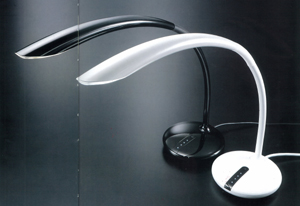
The company’s products, he said, are around one third to half the price of a genuine Italian lighting fixture. One such product is a Calla-named desk lamp that retails for about NT$10,000 (US$333.3 at US$1:NT$30).
Calla is typical of the company’s lighting fixtures, which highlight the combination of innovative designs with advanced processing techniques. “We make the Calla with a one-piece forming technique borrowed from the bicycle manufacturing industry,” the designer noted. The technique leaves no joints or seams on the desk lamp, giving it a perfectly smooth surface. The lamp has a special lens to soften illumination and a touch switch to add to the futuristic design.
Darfon Corp. has helped the lighting manufacturer design required power devices, including drivers and transformers, into the lamp base, as well as fix thermal problems.
iF Reddot Design Award Winner
Wellypower, which was founded as a manufacturer of cold cathode fluorescent lamps (CCFLs) and T5 fluorescent tubes, promoted LED lamps and CCFL lighting fixtures at this fair.
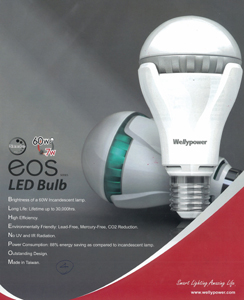
Its EOS LED PAR lamp and EOS LED light bulb won the 2011 iF Reddot Design Award. Behind the wining of the award is the lamps’ sleek look and unique thermal-dissipation design, which the company calls a “stack fin effect,” to dissipate heat faster than many competing designs.
The effect, according to the company, is achieved by a thermal module composed of 60 aluminum fin blades and a sleek white cover made out of polycarbonate (PC). Covering from the joint of the fin structure and plug screw up to the line close to the top of the fin structure, the cover is ventilated so that air can exhaust heat after passing over the fin structure.
The fin structure also makes the lamps around 60% lighter than lamps with a forged aluminum structure, according to the company.
Both lamps come in warm white 3,000K and cool white 5,700K varieties and are dimmable. Luminous efficacy is 64 lumens per watt for the cool white PAR lamp and 51 lumens per watt for the warm white. The light bulb produces 61 lumens per watt for cool white and 48 lumens per watt for warm white illumination.
Wellypower's CCFL lighting fixture line includes a 12W dimmable downlight, the Ronny Jr.-branded desk lamp and plant growing lights. CCFL grow lights are unusual in a market dominated by LED or traditional fluorescent lamps.
Next Generation LED Lighting
Nan Ya, founded by the Formosa Plastics Group (FPG) and 40% held by chipmaker Epistar Corp., displayed lighting fixtures for the first time at the Taipei lighting fair. The company branched into the lighting-fixture sector from epitaxy-wafer and chip packaging sectors.
Nan Ya has rolled out 10W and 20W T8 light tubes, 14W downlight, 100W and 140W streetlights, 5W and 7W light bulbs, as well as 7W grow light.
“FPG is an eco-conscious company, so it decided last year to produce LED lighting fixtures using its epitaxy-wafer and packaging capabilities,” said Crystal Cheng, a sales rep of the company’s LED Lighting Project Unit.
All of the company’s lighting fixtures are sold under the “ECO MAN”, “NYPI”, and “Horticulture” brands. “We’re a new entrant in the market. But FPG is known globally and represents good quality. So, we capitalize on our relationship with FPG when promoting our brand name. We join good quality with a cost advantage built on our integrated manufacturing capability,” Cheng said. The company has shipped its lighting fixtures to Europe.
In addition to its partnership with Epistar, currently Taiwan’s No. 1 LED chipmaker, Nan Ya has a high-caliber R&D team. The company has designed Epistar’s high-voltage (HV) LED chip into lighting fixtures that are available for both AC LED lighting fixtures and DC fixtures.
HV LED has been touted as the third generation of LED technology, after AC LED and DC LED, and Epistar is a pioneer. At the fair, Epistar promoted its HV LED technology along with a high-performance warm white lighting solution using the chips.
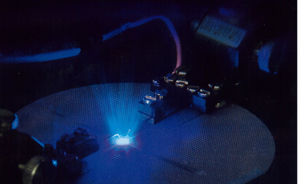
HV LED and AC LED chips share the same technological concept: carrying several cells on a chip to pile up voltage volume to fit the household 110-220V outlets. The prominent difference is: No bridge circuit is built on HV chip to connect all the cells in contrast to the structure on AC LED. The complicated manufacturing process makes AC LED pricier than DC and HV chips as each cell on it needs a pair of cathode and anode wires and each chip goes through several die-bonding processes. “HV chip requires only a pair of anode and cathode wires and goes through chip bonding only once, making it less expensive,” explained Joe Hsing, a sales executive of Epistar’s Sales Division III.
Without bridge circuits, an HV LED is an ordinary DC chip except for the high-voltage cells on it. “The design makes the chip conveniently available both for AC and DC lighting manufacturers and less expensive compared with AC LED,” Hsing said. “By outfitting an HV chip with external bridge circuits, you can adjust the chip for AC usage. Otherwise, you keep the chip intact for DC purpose,” he added.
AC LED is one of the factors boosting the cost of LED bulbs. The complicated manufacturing process is more expensive, though the result is a bulb that can screw into an ordinary household socket without a bulky transformer box. HV chips therefore help to bring the cost of LED lighting down closer to traditional lighting.
Nan Ya has introduced a 20V red chip and 48V blue chip. A 2.3-watt package of two red chips and two blue chips produces 270 lumens of 2,700K warm white light, with CRI higher than 85. A light module installed with four of the 2.3W package can put out 1,080 lumens while a module outfitted with six of the packages produces 1,620 lumens.
The company exhibited a HV package that delivers a 2,700K warm white light at CRI 90 and produces light intensity that equates to 98% of the intensity generated by a typical cool-white LED package composed of blue chips covered with yellow phosphor. Key to the solution is a red HV chip, two blue HV chips and yellow phosphor powder. Conventional warm-white solutions based on red phosphor and blue chips can attain around 60-70% and deliver a 70-80 CRI, the company’s statistics show.
AC-DC
Justenergy Technology Corp., an owner of JUSTLED-branded LED lighting, is an advocate of HV LED technology. According to the company’s president, Jefferson Chien, the company has stopped using AC LEDs in its lighting fixtures. “Instead, we use our patented T-Tech HV LED driver in our fixtures, allowing our DC lighting fixtures to directly plug into AC outlets,” Chien stressed.
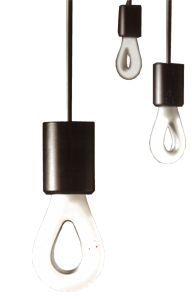
He said the company’s lighting fixtures with the T-Tech driver are dimmable and save 20-50% more electricity than competing lamps, boasting power factor of 88-95%. The T-Tech technology eliminates the need for an adaptor on the company’s lamps, giving the lamps a sleeker look.
At the fair, the company displayed a full range of T-Tech lighting fixtures from light bulbs, light tubes and desk lamps, to streetlights and pendant lamps. Many of them have been awarded with citations, including iF 2009, iF 2010 and iF 2010, International Design Excellent Awards 2010, Golden Pin Design Award, as well as Taiwan Excellence Awards.
Among the awarded products is a 4.5W light bulb with a hollow center, which equates to a 30W incandescent with its 320 lumens of brightness. The bulb combines classic elegance and seamless lines.
Smart Controls
The fair also highlighted the industry trend towards smarter lighting control systems.
GRT Technology Co., Ltd., a maker of wireless control and monitoring solutions for various applications, including home security, communications and lighting, exhibited a smart lighting control system for LED streetlights. “It is the first wireless type of control system for streetlights,” reported Danny Huang, the company’s sales manager.
Typically, the system controls streetlights by sending commands from a computer equipped with a segment gateway to local control node (LCN) fixed on each streetlight. ZigBee is the protocol standard for the wireless signal.
The computer has GRT-developed management software that can handle a lot of the chores, including regular on and off, changing light intensity, and identifying problematic lights. A timetable gateway allows the management system to store 12 intensity modes to meet different darkness conditions. “For instance, in the dimming dusk and dawn the intensity needs not be as strong as that in all dark. Also, intensity can be reduced when traffic volume tapers off in wee hours. This is an energy-saving design,” Huang stresses.
LCN works as a signal relay in addition to a command receiver. As a relay, it can send commands to the next streetlight by passing a broken one in between. A management computer basically handles a kilometer road of streetlights. “The control length can be extended depending on customer demands. We usually recommend one kilometer as an ideal length to customers,” Huang said.
Easy installation is a drawing point of the system. “Theoretically, our system supports various LED streetlights if there are no incompatible devices designed in,” Huang noted.
The company also sells a far-distance version of the control system, building the control on general packet radio system (GPRS). This version allows users to control the lights on GPRS-enabled devices connected to telecom service providers.
Six-channel Dimmer
Lite Puter Enterprise Co., Ltd., an ISO9001 certified manufacturer of architectural and stage lighting control systems, showed off indoor lighting at the show. Among them is a six-channel integrated dimmer pack dubbed as EDX-607, ideal for hotels, luxury residences and restaurants.
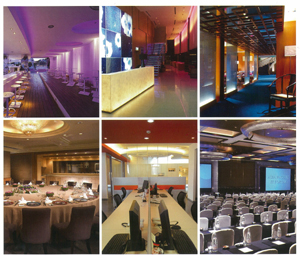
The system comes with six control channels, allowing it to connect to 12 loops of lamps of various types. Each channel has maximum current capacity of 10 amperes, suggesting the system’s high current output available for power-demanding lighting fixtures like giant chandeliers or outdoor lamps. A fin-like board fixed on the back of the system’s control panel dissipates heat to keep the device operating coolly under heavy loads.
The EDX-607 can store 12 light intensities matched with different ambiences and on/off times in its memory unit. Each intensity is dimmed seamlessly along the C3 liner dimming curve to set volume, making the system a helpful tool for lighting designers. Dimming and time-setting functions also can save power. The lamps also have a slow warm-up design to prevent damage from steep current surges.
The system can be linked to and monitored by PC via LitePuter DP-E Ethernet interfaces and control software.
According to a Lite Puter engineer who asked not to be named, EDX-607 has been verified by ETL Testing Lab. Inc. of North America. The company sells its lamps to both North America and Europe. In Taiwan, the company has supplied its control systems to 90% of five-star hotels, including the Grand Hyatt Hotel Taipei, Sheraton Hotel Taipei, Shangri-La’s Far Eastern Plaza Hotel, the Westin Taipei, and the Sherwood Taipei.
Dual Use Lighting
Just Power Integrated Technology Inc. promoted its “smart lighting” technology at the lighting show. The technology has a patented circuit design that enables general LED lighting fixtures to double as emergency lighting.
The lighting system is composed of an LED lighting fixture and a remote controller. The fixture is powered by lithium batteries that can store 2.5 hours of electricity for emergency purpose and be recharge over 500 times. What makes the emergency lighting system unusual is the remote controller. “Usually, emergency lighting automatically switches on when power fails and does not shut off until it runs out of power. So no remote controller is needed. Our product has a remote controller with a dimming circuit to save energy,” stressed the company’s president, Ching Yang.
Yang gave a live demonstration with the system, wirelessly turning off and on a lighting fixture after unplugging it from the power outlet. The lamps stay bright for one minute after losing power, buying users some time for moving to a safe position. As an anti-burglar function, users can also preset on-off timing and interval between two courses of lighting activation.
“Our product is a far cry from the ungainly traditional emergency lights with their questionable lifespan lead-acid battery,” Yang added.
The intelligent emergency lighting system has been patented in Taiwan, mainland China, France, Germany and Japan.
According to Yang, the company has set two business models for the emergency lighting system: marketing the remote controller to lighting fixture makers and marketing the whole system to lighting projects. “These two models leave us ample room to build both brand-name and contract-manufacturing operations,” he said.
The company is now developing a more eco-friendly controller that controls light intensity with photosensitive technology.
Gains With AIN
Impressive gains in LED packaging technology were also apparent at this year's lighting show. VisEra Technologies Co., Ltd., which is partly held by chipmaker Taiwan Semiconductor Manufacturing Co. (TSMC), exhibited an eight-inch AIN (aluminum nitride) wafer packed with grain-size packages on it at this fair to show its unique AIN-based wafer level packaging approach. The company is already known for silicon-wafer based LED packages.
According to B.J. Chang, Senior Director of VisEra’s LED Business Organization, the size of the company's wafer is unprecedented for the packaging purpose. “Some Japanese suppliers produce wafers only at 4.5 inches at most. Any size bigger than that poses higher technology challenge due to the warping at the perimeter of the wafer,” he said.
VisEra worked with the military-run Chungshan Institute of Science and Technology to develop the wafer, which is as smooth as a mirror. “AIN is 1.4 times better than silicon wafers and it outperforms aluminum oxide substrate in thermal conductivity by seven- to ten-fold,” Chang reported. AIN’s conductivity rate, he said, is 170-230 W/mK.
The material’s thermal expansion performance is almost as good as silicon’s, at 4.6 ppm per degree Celsius, ensuring it does not warp at high temperatures. “The wafer goes through an unorthodox manufacturing process, completed with 1,850 C of sintering,” Chang noted. Also, the wafer has excellent impact resistance.
The wafer is pricier than silicon wafers and aluminum oxide substrates, Chang conceded. “But we believe these merits can help back-end manufacturers bring down their production costs as they ensure durability of LED devices, high flawless output, and design friendliness,” he said. His company hopes to bring down the cost of the wafer to less than 100% that of aluminum oxide substrate when it ramps up production early next year.
The wafer is suitable for high-power LED packaging, each capable of carrying 654 four-chip packages.
Renewable Energy Lamps
TYC Brother Industrial Co., Ltd., which is recognized as Taiwan’s No. 1 auto lamp maker, highlighted its achievement in double energy-saving design for lighting with a HID streetlight powered by solar energy and wind power as well.
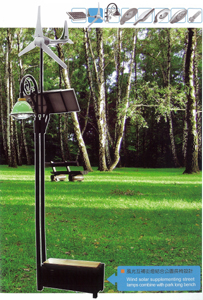
A typical 35W light of this type generates 3,300 lumens of luminosity with two 50W solar panels and a 600W wind turbine. “This light output is much higher than that of LED streetlights at this power rate,” said C.F. Chen, the company’s special-purpose lighting business unit. This light consumes around one kilowatt hour over a 24-hour non-stop operation.
The 4.5-6 meter lights are made to custom specifications. They join Osram ceramic HID lamps, solar panels and storage batteries, a wind turbine, control unit and lighting fixture. A streetlight with attached park bench is also available.
Aeon Lighting Technology Inc. (ALT), an affiliate of Supermicro Computer Inc., currently the world’s No. 3 industrial server maker, has been active in developing new applications with LED solutions.
At the Taipei lighting fair, the company demonstrated candle bulbs for chandeliers embedded with Cree 3W XP-E and 3W M-L warm white packages. “The XP-E and M-L chips inside the packages have yet to come on stream and ALT is the world’s first LED lighting manufacturer to use the two Cree chips,” reported Jerry Chou, an ALT PR specialist.
Despite the power-savings of LED lamps, most chandelier makers still use energy-gulping incandescent bulbs for the 100-CRI illumination that creates natural bling-bling effect through chandelier crystal ornaments.
XP-E delivers a 90 CRI while M-L is at 80. With unique lens designs, the company’s XP-E bulb boasts a light diffusion angle of 270 degree while its M-L bulb projects light at 180 degree.
The bulbs come in E11, E14, E17, E24/26, E26/27, and GU10/GZ10 lamp base specifications.
The company has shipped around 5,000 candle bulbs in each of the past few months, mostly to luxury hotels in Singapore, the Middle East, and Latin America.
According to Chou, ALT is developing a dimming circuit for the candle bulbs, making the bulbs more versatile in their applications.
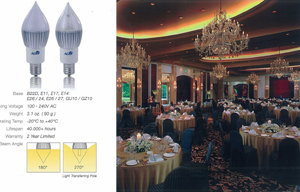
ALT also debuted a series of grow bulbs at the show. Its blue grow bulbs deliver 460-470 nanometers of light on a wavelength spectrum and the red bulbs deliver 620-625nm. According to Chou, the company is working with a university in Taiwan to build a greenhouse entirely lit by LED grow lights.

